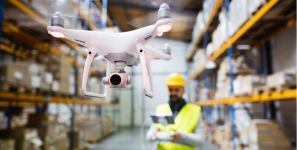The Future of Warehouse Safety: Harnessing Technology to Protect Workers in Automated Facilities
Warehouses can be hazardous, but they’re getting safer. Much of that improvement stems from new technologies, with automation leading the charge.
Automated facilities are far safer than conventional operations in many ways. At the same time, robots introduce unique hazards that warehouses must contend with. In both cases, technological innovation is the answer to better safety.
Automation as a Safety Measure
Warehouse automation has historically trailed behind other heavy industries like manufacturing, but that’s starting to change. Over 70% of logistics businesses use some form of mobile robot today. This shift improves safety along two major lines — automating dangerous tasks and minimizing errors.
Automating Dangerous Tasks
Automation’s most significant safety advantage is that it removes workers from the most hazardous parts of the job. When human employees don’t need to carry the heaviest loads or reach the highest shelves, it has the same impact as if these hazards didn’t exist.
Automation can’t perform every job a human can, but the most dangerous work is often easily automated. Carrying heavy loads or picking items from high shelves are straightforward, predictable tasks — just the kind automation excels at.
Automated tasks don’t have to be dangerous to improve workplace safety. Overexertion accounts for 23% of all workplace injuries and often stems from repetitive motion. Warehouses that automate material-handling workflows minimize this motion, preventing one of the most common causes of injury.
Error Reduction
Automated warehouses are also safer because they minimize human error-related risks. Mistakes play a role in almost all workplace safety incidents, so companies that reduce errors will also reduce injuries.
Autonomous alternatives to manually operated machines make some of the biggest impacts in this area. For example, conventional forklifts pose severe threats because driver errors are likely, as humans are easily distracted. Robot forklifts, by contrast, don’t get preoccupied or bored, so they’re less likely to make errors that endanger nearby workers.
It’s also worth noting that automation reduces the workload in labor-strained warehouses. Workers can feel less stressed when there’s less to do, letting them focus on what they’re doing, further preventing dangerous errors.
Keeping Workers Safe From Robots
Of course, automation itself can introduce new workplace hazards. The answer to these risks is not to avoid automation but to implement new technologies that make it safer.
Reliable Navigation
One of the most important steps in improving robot-related safety is ensuring they can navigate reliably. Moving equipment like forklifts is responsible for many injuries and OSHA violations, and mobile robots pose several of the same risks. An automated guided vehicle (AGV) that can’t identify obstacles and pedestrians quickly and accurately could cause harmful collisions.
Cameras and machine vision software are improving, which makes mobile robots safer by default. Besides these improvements, warehouses can capitalize on the Internet of Things (IoT) to enable better navigation. Robots that communicate with real-time sensors throughout the facility can move through it more effectively.
Edge computing takes these benefits further, as it spreads complex compute tasks between nearby devices, enabling faster responses. 5G networks can also provide more bandwidth and higher speeds to support these processes.
Adaptable Cobots
Collaborative robots (cobots) are another important technology that makes automated warehouses safer. These robots are designed to work alongside humans instead of replacing them. As such, they’re less likely to run into workers or cause disruptions that may lead to injury.
Adaptability is a key feature here. Cobots can respond to real-time data, often through IoT connectivity. As a result, they can adjust their workflow as necessary as conditions change to prevent mistakes that may endanger workers or keep out of people’s way even when they don’t follow predictable paths.
Amazon has implemented cobots extensively to impressive results. One of its solutions, Sequoia, combines multiple robotic systems to organize and move inventory throughout the warehouse. Combining separate systems lets it adapt as needed, and the design emphasizes making things easier for human workers. As a result, recordable incident rates dropped by 15% between 2021 and 2022.
Artificial Intelligence
It’s impossible to talk about disruptive technologies and not mention artificial intelligence (AI). AI can improve robot safety in warehouses in several ways, and its potential will likely grow as this technology advances.
AI-guided robots are more adaptable than classical alternatives, making them safer. Machine learning models can identify and respond to hazards in a fraction of a second, making them ideal for guided mobile robots to prevent collisions. Similarly, AI can help robots interpret situations to determine the best course of action to remain productive and keep human co-workers safe.
AI can also analyze data from across a warehouse to identify where the most accidents happen. Some models can go further and suggest possible improvements, making it easier to effectively reduce workplace injuries over time.
New Tech Is Transforming Warehouse Safety
Technology is one of warehouses’ greatest assets when addressing worker safety. The logistics and supply chain industries will become safer as more facilities embrace automation and complementary technologies.
Tech adoption isn’t a panacea to all workplace safety issues, but it offers substantial improvements. Warehouse managers must integrate these solutions into existing safety programs and combine them with other steps to become as safe as possible.





Leave a Reply